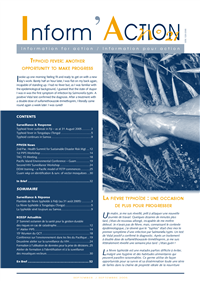Contents
Typhoid fever
- Typhoid fever outbreak in Fiji – Situation as at 31 August 2005
Dr Timaima Tuiketei, Dr Ili Kubuabola and Dr Joe Koroivueta (PDF, 18 KB) - Typhoid fever in Tongatapu (Tonga)
Dr Siale ‘Akau’ola (PDF, 27 KB) - Typhoid continues in Samoa
Dr Nuualofa Tuuau Potoi, Dr Siniva Sinclair and Mr Sinei Fili (PDF, 24 KB)
Meetings
- Second Pacific Health Summit for Sustainable Disaster Risk Management – Dr Tom Kiedrzynski (PDF, 17 KB)
- 1st PIPS Workshop – Noumea, New Caledonia, May 2005 (PDF, 25 KB)
- TAG 15 Meeting – Beijing, China, June 2005 – Richard Duncan (PDF, 11 KB)
- Pacific Island Environmental Conference – Guam, June 2005 –
Dr Narendra Singh (PDF, 25 KB) - Second HIV Surveillance Workshop – Nadi, Fiji, August 2005 –
Tim Sladden (PDF, 11 KB)
Training
- Data for Decision Making (DDM) Training – a Pacific Model of FETP commences – Dr Narendra Singh (PDF, 21 KB)
- Guam Training Workshop on Identification and Surveillance of Vector Mosquitoes, July 2005 – Laurent Guillaumot (PDF, 23 KB)
In Brief
- Samoa Commitment supports PPHSN development (PDF, 16 KB)
- Updated HBAS Manual (PDF, 11 KB)
- PacNet figures as at 31 August 2005 (HTML, 11 KB)
- Infection Control Specialist for PPHSN (HTML, 10 KB
Editorial
Typhoid fever: another opportunity to make progress
I woke up one morning feeling fit and ready to get on with a new day’s work. Barely half an hour later, I was flat on my back again, incapable of standing up. I had no fever but, as I was familiar with the epidemiological background, I guessed that the state of stupor I was in was the first symptom of infection by Salmonella typhi. A positive Vidal test confirmed the diagnosis. After treatment with a double dose of sulfamethoxazole-trimethoprim, I literally came round again a week later: I was cured!
Typhoid fever is a disease that can be difficult to avoid, despite apparently reasonable hygiene standards and diet. This germ opportunistically uses a series of flaws in the ideal food and water safety chain for its survival and dissemination. The existence of healthy carriers/spreaders adds an ironic and efficient note. The disease’s sometimes long incubation period, in particular when the infective dose is low, can make identification difficult. In an environment where resources are limited, the epidemiological tools that enable us to obtain an appropriate description of the problem (descriptive epidemiology) and to assess and determine the possible cause(s) (analytical epidemiology) are essential to help Pacific Island health professionals cope better with epidemic diseases and apply the new International Health Regulations. To familiarise them with these tools, and as far as possible with their use in a real situation, is one of the objectives set by the PPHSN partners.
Surveillance of the EPI target diseases is continuing to develop under PPHSN. Faced with a resurgence of poliomyelitis in Africa and its spread eastwards as far as Indonesia, a country on the Pacific Rim, maintenance of good vaccine coverage for this disease remains important. The two pillars of the EPI strategy are at present measles elimination and Hepatitis B control, but new impetus is also being given to active surveillance in the hospital setting for acute flaccid paralysis, neonatal tetanus and acute rash and fever, as well as the strengthening of LabNet by WHO for the confirmation of measles cases.
We will soon be entering the northern hemisphere influenza season. Even if avian influenza is not one of the topics this issue is focusing on, we must continue with preparedness work for the potential threat of an influenza pandemic. The now endemic nature of avian flu in Southeast Asia, its geographical spread over both hemispheres and the simultaneous presence of other type A flu viruses in humans are increasing the risk of genetic recombination with a human virus and the emergence of a new virus more capable than H5N1 of inter-human transmission. The recent meeting of the WHO Regional Committee in Noumea strongly raised awareness in Pacific Island decision-makers and aid donors and should make it possible to speed up the process of planning for an influenza pandemic. It should not be forgotten that Indonesia, a densely populated country with a lot of domestic poultry, is affected by avian flu, placing the potential problem on the doorstep of the Pacific. The Second Pacific Health Summit for Sustainable Disaster Risk Management, organised in June by the CDC PEHI Project[1] in the Fiji Islands, produced a project proposal aiming to strengthen influenza pandemic preparedness. This proposal is summarised in this issue. Some donors, New Zealand in particular, have clearly stated their interest in funding such a project.
In conclusion, I would like to finish on the positive note introduced by Dr Siale ‘Akau’ola: the challenges like those offered by typhoid fever in the region are opportunities to improve our health services and to find solutions to the many problems affecting or threatening the health of our communities.
Dr Tom Kiedrzynski
SPC Epidemiologist

